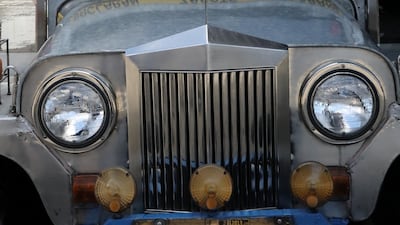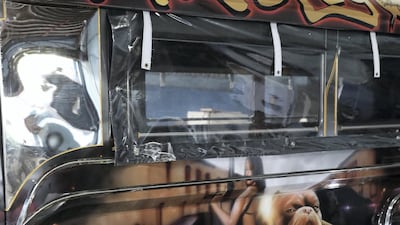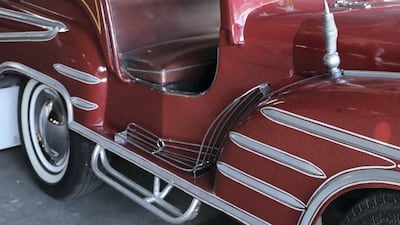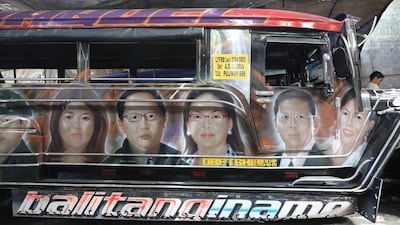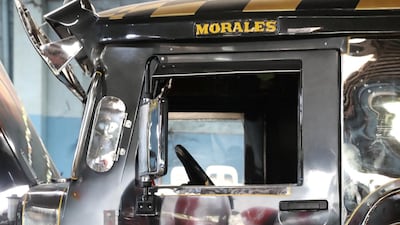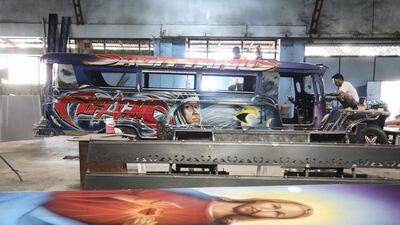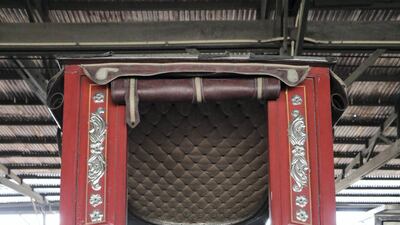Jeepneys are a subject that has divided the Philippines: almost as much as President Rodrigo Duterte's suggestion of renaming the country Maharlika.
These vehicles – the name of which is likely a portmanteau of the words "jeep" and "jitney" – were originally fashioned out of US military jeeps left over from the Second World War. Since then, the colourful, hand-painted vans, dubbed "King of the Road", have become as synonymous with Filipino culture as black cabs are to London and gondolas are to Venice. In fact, French fashion house Christian Louboutin even released a jeepney-themed handbag collection last year, made with hand-woven fabric indigenous to the Philippines. Embroidered on the front of the Manilacaba multi-pattern totes were the words "CL love Manila"; colourful jeepneys were sewn into the inner lining, with signage sporting common phrases such as "Chic Makati" and "No Selfies!".
The manufacture of these gas-guzzlers has been big business in the Philippines since they became a popular and inexpensive way of re-establishing a public transport network after the war. A healthy form of self-expression rose with them; the culture of jeepney folk art began to evolve in the mid-1940s. Jeepney manufacturers commonly employed teams of artists to hand-paint and decorate the exteriors, while private operators adorned their own.
The evolution of jeepney folk art
Splashes of colour were added to monochromatic bodies; fenders were replaced with grille scoops; stainless-steel cut-outs were added alongside accessories that ranged from ornaments on the hood to custom-made hub caps. Hand-painted murals became commonplace, as artists depicted everything from their own family members to religious icons and popular characters from their favourite movies or anime series. More and more rickety, exotically painted, smoke-belching jeepneys navigated the Philippines' increasingly congested streets, sporting witty slogans written in any of the country's 100-plus languages and dialects, alongside caricatures, crazy patterns and any manner of pop culture references. It became a globally recognised cultural tradition of the Philippines and, yet, like Marmite, jeepneys are divisive: some people love them, while others hate them.
Those firmly in the first camp appreciate how the vehicles have provided countless drivers – and artists – with work since the '40s. Their cost-effectiveness is undeniable, too – with trips at eight or nine Philippine pesos (50 fils) a pop, depending on whether you're in a city or a province. This form of public transportation has served the country's mass of minimum-wage workers well over the years. Naysayers, on the other hand, lament the serious issue of traffic congestion, particularly in Metro Manila, as well as rising air pollution, the growing number of road accidents and on-board overcrowding (they can carry about 13 passengers, although operators usually pack in far more people).
Modernising public transport in the Philippines
The government's Public Utility Vehicle Modernisation Programme (PUVMP), which was revealed in 2017, was meant to fix all that, though. President Duterte announced older public utility jeepneys would be phased out and modernised by 2020. But this caused a rift in society, with transport union groups up in arms about the move. "The immediate effect is the massacre of livelihoods of an estimated 250,000 small jeepney operators and almost 600,000 jeepney drivers," George San Mateo, head of transport group Pinagkaisang Samahan ng mga Tsuper at Operator Nationwide (Piston), told the South China Morning Post.
Mateo and fellow members of Piston have been extremely vocal in their opposition to the PUVMP over the past two years, organising protests and strikes, some of which have seen San Mateo arrested. "Jeepneys were supposed to be a stopgap measure," Steve Ranjo, Piston's secretary general, told the Los Angeles Times. "The government abdicated their job providing transport as a public service. Trains should be the backbone of a transportation system, but they're focusing on small-capacity vehicles like ours. They're not interested in mass transportation. They're interested in business."
While the government continues to insist the programme is not intended to alienate lower-income jeepney operators, and is introducing financing schemes because the modernised vehicles are much more expensive than older iterations, Mateo claims this isn’t enough. He describes the plans and support as “very minuscule, very puny”: original jeepneys cost about 700,000 Philippine pesos, while the new vehicles cost up to 1.8 million Philippine pesos, and about 80,000 Philippine pesos is to be subsidised. As drivers commonly earn an average of about 500 to 600 Philippine pesos for two days of work, to raise the capital to invest in the new vehicles is, for many smaller operators, out of the question.
Meet the artists
This, unsurprisingly, has meant the tradition of jeepney folk art has begun to fizzle out, too. The successor vehicles are being touted as a big improvement on the older models that have traditionally ploughed the streets of the Philippines; they have proper doors, seats for everyone, air-conditioning and standing room. But their mass production will ensure identikit designs, dampening the creative spirits of the artists who have hand-painted and airbrushed the exteriors for years, not to mention making the roads a little less colourful. As the number of local operators continues to decline, many artists are struggling.
Bernardo "Nards" de la Cruz, 65, is one of the pioneers of the jeepney design movement. He started turning these utilised American military vehicles into moving canvasses back in the '60s, beginning as a designer at the now-defunct Francisco Motors, before moving to San Pablo, Laguna, to work for Armak Motors Corporation. De la Cruz has made a successful living out of his chosen profession, having raised four children on the wages he has earned over the years, and yet, now, he's the last painter left at one of the biggest and oldest jeepney manufacturers in the country, Sarao Motors in Las Pinas, Metro Manila.
He remembers the heyday, back in the '60s and '70s, when he would make about 1,500 Philippine pesos to work on a 7,000 Philippine pesos Sarap jeepney. Now, he tells The National he has seen a serious decline in orders, and he bemoans the dying art of jeepney design.
He continues to work on them, but has had to take on a couple of side hustles: he works on commissions, and makes storefront signs. And, while he’s happy his country is committed to progress and saving the environment, he disagrees with what he calls the PUVMP’s “hidden agendas”, such as bringing in foreign corporations to do business in the Philippines as local companies go bankrupt.
De la Cruz says he can survive – "as long as there is commissioned work, I will still put some food on the table," he says – but other artists may not be as fortunate. Jeepney sign-board painter Dolly Paberecio, 28, for one, is struggling to make ends meet. She and her husband, who run a shop in Manila together, have had to start taking any job they can find. On good days, they sell four to five sign-boards, each costing about 25 Philippine pesos. On bad days, the orders drop to two, maybe three. With a daughter about to turn three years old, Paberecio is keen to find other work. On the PUVMP she certainly doesn't mince her words: "If that's what the government wants, so be it," she tells The National. "If they want many people to starve, then I guess people will resort to other things."
Airbrush artist Mark Binamira, 30, is also finding it difficult to adjust to this brave new jeepney market. He used to work full-time for Morales Motors – a manufacturing company known for its hyper-stylised jeepneys popular among the youth thanks to their radical designs – but now, since orders are few and far between, he only goes in once or twice a week. The rest of the time he freelances, working on tricycles (another popular form of transportation in the Philippines), trucks and painting houses. He, like de la Cruz, is working to adapt. "It is what it is," he says. "We move on to where we can to survive."
It doesn’t matter where you stand on the issue of the PUVMP, the demise of jeepney folk art also tells another classic present-day tale: of tradition being trumped by modernity and technological advancement. And, as usual, those caught in the middle, are being left behind.
Our legal consultant
Name: Dr Hassan Mohsen Elhais
Position: legal consultant with Al Rowaad Advocates and Legal Consultants.
Mohammed bin Zayed Majlis
How to avoid crypto fraud
- Use unique usernames and passwords while enabling multi-factor authentication.
- Use an offline private key, a physical device that requires manual activation, whenever you access your wallet.
- Avoid suspicious social media ads promoting fraudulent schemes.
- Only invest in crypto projects that you fully understand.
- Critically assess whether a project’s promises or returns seem too good to be true.
- Only use reputable platforms that have a track record of strong regulatory compliance.
- Store funds in hardware wallets as opposed to online exchanges.
UJDA CHAMAN
Produced: Panorama Studios International
Directed: Abhishek Pathak
Cast: Sunny Singh, Maanvi Gagroo, Grusha Kapoor, Saurabh Shukla
Rating: 3.5 /5 stars
TWISTERS
Director: Lee Isaac Chung
Starring: Glen Powell, Daisy Edgar-Jones, Anthony Ramos
Rating: 2.5/5
Like a Fading Shadow
Antonio Muñoz Molina
Translated from the Spanish by Camilo A. Ramirez
Tuskar Rock Press (pp. 310)
About Tenderd
Started: May 2018
Founder: Arjun Mohan
Based: Dubai
Size: 23 employees
Funding: Raised $5.8m in a seed fund round in December 2018. Backers include Y Combinator, Beco Capital, Venturesouq, Paul Graham, Peter Thiel, Paul Buchheit, Justin Mateen, Matt Mickiewicz, SOMA, Dynamo and Global Founders Capital
THE SPECS
Engine: AMG-enhanced 3.0L inline-6 turbo with EQ Boost and electric auxiliary compressor
Transmission: nine-speed automatic
Power: 429hp
Torque: 520Nm
Price: Dh360,200 (starting)
Apple%20Mac%20through%20the%20years
%3Cp%3E1984%20-%20Apple%20unveiled%20the%20Macintosh%20on%20January%2024%3Cbr%3E1985%20-%20Steve%20Jobs%20departed%20from%20Apple%20and%20established%20NeXT%3Cbr%3E1986%20-%20Apple%20introduced%20the%20Macintosh%20Plus%2C%20featuring%20enhanced%20memory%3Cbr%3E1987%20-%20Apple%20launched%20the%20Macintosh%20II%2C%20equipped%20with%20colour%20capabilities%3Cbr%3E1989%20-%20The%20widely%20acclaimed%20Macintosh%20SE%2F30%20made%20its%20debut%3Cbr%3E1994%20-%20Apple%20presented%20the%20Power%20Macintosh%3Cbr%3E1996%20-%20The%20Macintosh%20System%20Software%20OS%20underwent%20a%20rebranding%20as%20Mac%20OS%3Cbr%3E2001%20-%20Apple%20introduced%20Mac%20OS%20X%2C%20marrying%20Unix%20stability%20with%20a%20user-friendly%20interface%3Cbr%3E2006%20-%20Apple%20adopted%20Intel%20processors%20in%20MacBook%20Pro%20laptops%3Cbr%3E2008%20-%20Apple%20introduced%20the%20MacBook%20Air%2C%20a%20lightweight%20laptop%3Cbr%3E2012%20-%20Apple%20launched%20the%20MacBook%20Pro%20with%20a%20retina%20display%3Cbr%3E2016%20-%20The%20Mac%20operating%20system%20underwent%20rebranding%20as%20macOS%3Cbr%3E2020%20-%20Apple%20introduced%20the%20M1%20chip%20for%20Macs%2C%20combining%20high%20performance%20and%20energy%20efficiency%3Cbr%3E2022%20-%20The%20M2%20chip%20was%20announced%3Cbr%3E2023%20-The%20M3%20line-up%20of%20chip%20was%20announced%20to%20improve%20performance%20and%20add%20new%20capabilities%20for%20Mac.%3C%2Fp%3E%0A
GOLF’S RAHMBO
- 5 wins in 22 months as pro
- Three wins in past 10 starts
- 45 pro starts worldwide: 5 wins, 17 top 5s
- Ranked 551th in world on debut, now No 4 (was No 2 earlier this year)
- 5th player in last 30 years to win 3 European Tour and 2 PGA Tour titles before age 24 (Woods, Garcia, McIlroy, Spieth)
The schedule
December 5 - 23: Shooting competition, Al Dhafra Shooting Club
December 9 - 24: Handicrafts competition, from 4pm until 10pm, Heritage Souq
December 11 - 20: Dates competition, from 4pm
December 12 - 20: Sour milk competition
December 13: Falcon beauty competition
December 14 and 20: Saluki races
December 15: Arabian horse races, from 4pm
December 16 - 19: Falconry competition
December 18: Camel milk competition, from 7.30 - 9.30 am
December 20 and 21: Sheep beauty competition, from 10am
December 22: The best herd of 30 camels
Avatar: Fire and Ash
Director: James Cameron
Starring: Sam Worthington, Sigourney Weaver, Zoe Saldana
Rating: 4.5/5
Ireland v Denmark: The last two years
Denmark 1-1 Ireland
7/06/19, Euro 2020 qualifier
Denmark 0-0 Ireland
19/11/2018, Nations League
Ireland 0-0 Denmark
13/10/2018, Nations League
Ireland 1 Denmark 5
14/11/2017, World Cup qualifier
Denmark 0-0 Ireland
11/11/2017, World Cup qualifier
In-demand jobs and monthly salaries
- Technology expert in robotics and automation: Dh20,000 to Dh40,000
- Energy engineer: Dh25,000 to Dh30,000
- Production engineer: Dh30,000 to Dh40,000
- Data-driven supply chain management professional: Dh30,000 to Dh50,000
- HR leader: Dh40,000 to Dh60,000
- Engineering leader: Dh30,000 to Dh55,000
- Project manager: Dh55,000 to Dh65,000
- Senior reservoir engineer: Dh40,000 to Dh55,000
- Senior drilling engineer: Dh38,000 to Dh46,000
- Senior process engineer: Dh28,000 to Dh38,000
- Senior maintenance engineer: Dh22,000 to Dh34,000
- Field engineer: Dh6,500 to Dh7,500
- Field supervisor: Dh9,000 to Dh12,000
- Field operator: Dh5,000 to Dh7,000
Book%20Details
%3Cp%3E%3Cem%3EThree%20Centuries%20of%20Travel%20Writing%20by%20Muslim%20Women%3C%2Fem%3E%3Cbr%3E%3Cstrong%3EEditors%3A%20%3C%2Fstrong%3ESiobhan%20Lambert-Hurley%2C%20Daniel%20Majchrowicz%2C%20Sunil%20Sharma%3Cbr%3E%3Cstrong%3EPublisher%3A%20%3C%2Fstrong%3EIndiana%20University%20Press%3B%20532%20pages%3Cbr%3E%3C%2Fp%3E%0A
Libya's Gold
UN Panel of Experts found regime secretly sold a fifth of the country's gold reserves.
The panel’s 2017 report followed a trail to West Africa where large sums of cash and gold were hidden by Abdullah Al Senussi, Qaddafi’s former intelligence chief, in 2011.
Cases filled with cash that was said to amount to $560m in 100 dollar notes, that was kept by a group of Libyans in Ouagadougou, Burkina Faso.
A second stash was said to have been held in Accra, Ghana, inside boxes at the local offices of an international human rights organisation based in France.
The burning issue
The internal combustion engine is facing a watershed moment – major manufacturer Volvo is to stop producing petroleum-powered vehicles by 2021 and countries in Europe, including the UK, have vowed to ban their sale before 2040. The National takes a look at the story of one of the most successful technologies of the last 100 years and how it has impacted life in the UAE.
Read part four: an affection for classic cars lives on
Read part three: the age of the electric vehicle begins
Read part one: how cars came to the UAE
Dr Afridi's warning signs of digital addiction
Spending an excessive amount of time on the phone.
Neglecting personal, social, or academic responsibilities.
Losing interest in other activities or hobbies that were once enjoyed.
Having withdrawal symptoms like feeling anxious, restless, or upset when the technology is not available.
Experiencing sleep disturbances or changes in sleep patterns.
What are the guidelines?
Under 18 months: Avoid screen time altogether, except for video chatting with family.
Aged 18-24 months: If screens are introduced, it should be high-quality content watched with a caregiver to help the child understand what they are seeing.
Aged 2-5 years: Limit to one-hour per day of high-quality programming, with co-viewing whenever possible.
Aged 6-12 years: Set consistent limits on screen time to ensure it does not interfere with sleep, physical activity, or social interactions.
Teenagers: Encourage a balanced approach – screens should not replace sleep, exercise, or face-to-face socialisation.
Source: American Paediatric Association
CABINET%20OF%20CURIOSITIES%20EPISODE%201%3A%20LOT%2036
%3Cp%3E%3Cstrong%3EDirector%3A%20%3C%2Fstrong%3EGuillermo%20del%20Toro%3Cbr%3E%3Cstrong%3EStars%3A%3C%2Fstrong%3E%20Tim%20Blake%20Nelson%2C%20Sebastian%20Roche%2C%20Elpidia%20Carrillo%3Cbr%3ERating%3A%204%2F5%3C%2Fp%3E%0A
More from Neighbourhood Watch:
How to apply for a drone permit
- Individuals must register on UAE Drone app or website using their UAE Pass
- Add all their personal details, including name, nationality, passport number, Emiratis ID, email and phone number
- Upload the training certificate from a centre accredited by the GCAA
- Submit their request
What are the regulations?
- Fly it within visual line of sight
- Never over populated areas
- Ensure maximum flying height of 400 feet (122 metres) above ground level is not crossed
- Users must avoid flying over restricted areas listed on the UAE Drone app
- Only fly the drone during the day, and never at night
- Should have a live feed of the drone flight
- Drones must weigh 5 kg or less
WOMAN AND CHILD
Director: Saeed Roustaee
Starring: Parinaz Izadyar, Payman Maadi
Rating: 4/5
Visit Abu Dhabi culinary team's top Emirati restaurants in Abu Dhabi
Yadoo’s House Restaurant & Cafe
For the karak and Yoodo's house platter with includes eggs, balaleet, khamir and chebab bread.
Golden Dallah
For the cappuccino, luqaimat and aseeda.
Al Mrzab Restaurant
For the shrimp murabian and Kuwaiti options including Kuwaiti machboos with kebab and spicy sauce.
Al Derwaza
For the fish hubul, regag bread, biryani and special seafood soup.
Freezer tips
- Always make sure food is completely cool before freezing.
- If you’re cooking in large batches, divide into either family-sized or individual portions to freeze.
- Ensure the food is well wrapped in foil or cling film. Even better, store in fully sealable, labelled containers or zip-lock freezer bags.
- The easiest and safest way to defrost items such as the stews and sauces mentioned is to do so in the fridge for several hours or overnight.
Our Time Has Come
Alyssa Ayres, Oxford University Press
'Morbius'
Director: Daniel Espinosa
Stars: Jared Leto, Matt Smith, Adria Arjona
Rating: 2/5
